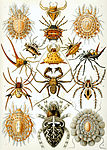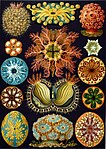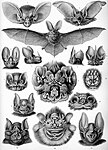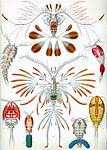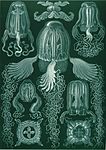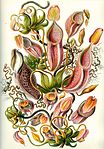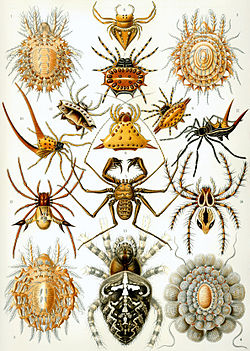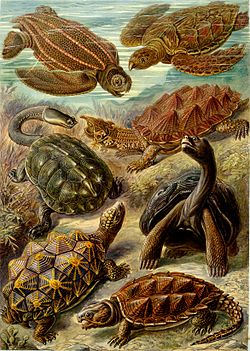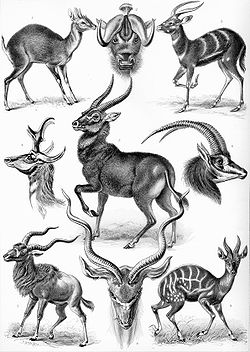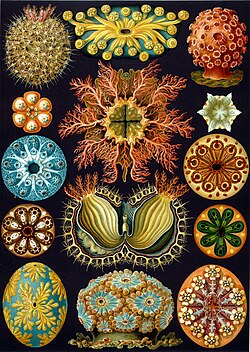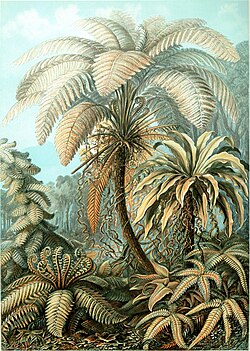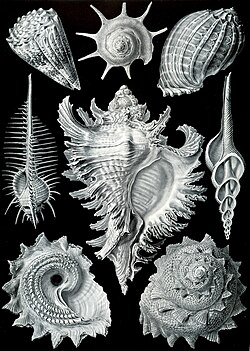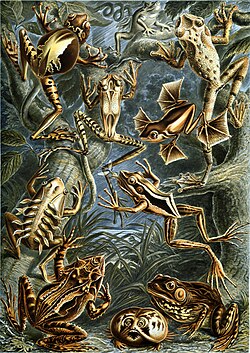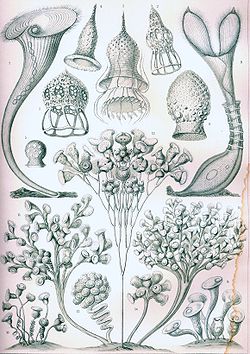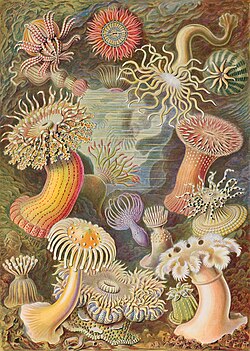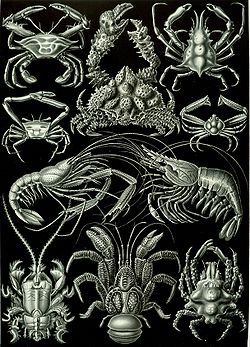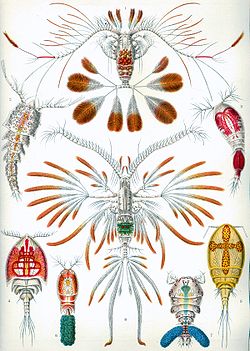Kunstformen der Natur


Kunstformen der Natur (tyska för Naturens konstformer) är en bok med litografier av den tyska biologen Ernst Haeckel. Bilderna i boken blev först publicerade i samlingar om tio mellan 1899 och 1904 och som en fullständig samling 1904. Den består av hundra bilder av diverse organismer, av vilka många Haeckel var den första av beskriva. I hans karriär gjordes över tusen etsningar av Haeckels skisser och akvareller, de bästa av dessa valdes ut till Kunstformen der Natur till vilken Adolf Giltsch gjorde de litografiska mallarna.[1] Den andra utgåvan av Kunstformen, med endast 30 av bilderna, gavs ut 1924.
Kunstformen der Natur sammankopplade vetenskapen med konsten och hade inflytande på 1900-talets konst, arkitektur och design. Många konstnärer som är förknippade med Art Nouveau blev influerade av Haeckels bilder, bland annat René Binet, Karl Blossfeldt, Hans Christiansen och Émile Gallé. Ett framstående exempel är byggnaden Beurs van Berlage, som designades av Hendrik Petrus Berlage, är delvis influerad av illustrationer i Kunstformen.[2]
Bildgalleri
Vetenskapliga namn som Haeckel använde är kursiva.
- Anemoner (Actiniae)
- Anthomedusae
- Antilopina
- Spindeldjur (Arachnida)
- Ascidiae
- Grodor (Batrachia)
- Mossdjur (Bryozoa)
- Chelonia
- Ciliata
- Chaetopoda
- Fladdermus (Chiroptera)
- Barrväxter (Coniferae)
- Hoppkräftor (Copepoda)
- Kubmaneter (Cubomedusae)
- Tiofotade kräftdjur (Decapoda)
- Bläckfiskar (Gamochonia)
- Filicinae
- Ödlor (Lacertilia)
- Muscinae
- Nepenthaceae
- Nakensnäckor (Nudibranchia)
- Narcomedusae
- Orkidéer (Orchidae)
- Koffertfiskar (Ostraciontes)
- Framgälade snäckor Prosobranchia (föråldrat namn)
- Siphonophorae
- Spumellaria
- Stephoidea
- Nattfjärilar (Tineida)
- Kolibrier (Trochilidae)
- Tubulariae
Referenser
- Den här artikeln är helt eller delvis baserad på material från engelskspråkiga Wikipedia.
- Breidbach, Olaf. Visions of Nature: The Art and Science of Ernst Haeckel. Prestel Verlag: Munich, 2006.
 Wikimedia Commons har media som rör Kunstformen der Natur (alla 100 bilder).
Wikimedia Commons har media som rör Kunstformen der Natur (alla 100 bilder).
Media som används på denna webbplats

- Chirodropus palmatus (Haeckel) = Chirodropus palmatus Haeckel, 1880, from the side
- Chiropsalmus quadrigatus (Haeckel) = Chiropsoides quadrigatus (Haeckel, 1880), from the side
- Charybdea obeliscus (Haeckel) = Carybdea obeliscus Haeckel, 1880 / Alatina obeliscus (Haeckel, 1880)?, from the side
- Charybdea obeliscus (Haeckel) = Carybdea obeliscus Haeckel, 1880 / Alatina obeliscus (Haeckel, 1880)?, alimentary tract
- Charybdea murrayana (Haeckel) = Carybdea murrayana Haeckel, 1880, from below
- Charybdea murrayana (Haeckel) = Carybdea murrayana Haeckel, 1880, from above
- Procharybdis tetraptera (Haeckel) = Alatina tetraptera (Haeckel, 1880), from the side
- Tamoya prismatica (Haeckel) = Tamoya haplonema F.Müller, 1859, from the side
Haeckel named D. annasethe after his wife Anna Sethe, who died the year before Haeckel observed the organism.
6-8: Scrawled Cowfish 9: Striped Cowfish 10: Humpback Turretfish

- Tegeocranus hericius (Michael) = Protocepheus hericius (Michael, 1887), a type of mite
- Tegeocranus latus (Koch) = Cepheus latus C.L.Koch, 1836, mites
- Tegeocranus cepheiformis (Nicolet) = Cepheus cepheiformis (Nicolet, 1855)
- Leiosoma palmicinctum (Michael) = Tereticepheus palmicinctum (Michael, 1880), a mite
- Phrynus reniformis (Olivier) = Phrynichus reniformis (Linnaeus, 1758) / Phrynichus ceylonicus (C.L.Koch, 1843), a tailless whipscorpion
- Arkys cordiformis (Walckenaer) = Gnolus cordiformis (Nicolet, 1849), an orb-weaver spider
- Gasteracantha cancriformis (Latreille) = Gasteracantha cancriformis (Linnaeus, 1758), orb-weaver spider
- Gasteracantha acrosomoïdes (Koch) = Acrosomoides acrosomoides (O. P.-Cambridge, 1879), a type of orb-weaver spider
- Gasteracantha geminata (Koch) = Gasteracantha geminata (Fabricius, 1798)
- Gasteracantha arcuata (Koch) = Macracantha arcuata (Fabricius, 1793)
- Acrosoma hexacanthum (Hahn) = Gasteracantha cancriformis (Linnaeus, 1758)
- Acrosoma spinosum (Koch) = Micrathena schreibersi (Perty, 1833)
- Acrosoma bifurcatum (Hahn) = Micrathena furcata (Hahn, 1822)
- Oxyopes variegatus (Hahn) (non Latreille, 1806: preoccupied) = Oxyopes ramosus (Martini & Goeze, in Lister, 1778)
- Epeira diadema (Linné) = Araneus diadematus Clerck, 1757
German:
1: Dornkronen-Moosmilbe (Nymphe). 0,6 mm. Europa.
2: Stachelkranz-Moosmilbe (Nymphe). 0,9 mm. Europa.
3: Gefiederte Moosmilbe (Nymphe). 0,62 mm. Europa.
4: Blattgürtel-Moosmilbe (Nymphe). 1,0 mm. Europa.
5: Nierenförmiger Geißelskorpion. Natürliche Größe. Ostindien.
6: Herzförmige Arkysspinne. 2mal vergrößert. Amerika.
7: Krabbenförmige Stachelspinne. 3mal vergrößert. Brasilien.
8: Dreieckige Stachelspinne. 5mal vergrößert. Madagaskar.
9: Doppeldornige Stachelspinne. 3mal vergrößert. Ostindien.
10: Bogendornige Stachelspinne. 2mal vergrößert. Java.
11: Sechsspitzige Stachelspinne. 4mal vergrößert. Brasilien.
12: Dickdornige Stachelspinne. 2mal vergrößert. Südamerika.
13: Zweigabelige Stachelspinne. 4mal vergrößert. Brasilien.
14: Bunte Springspinne. 3mal vergrößert. Deutschland.
15: Fromme Kreuzspinne. 3mal vergrößert. Deutschland.
Full text description (in German):
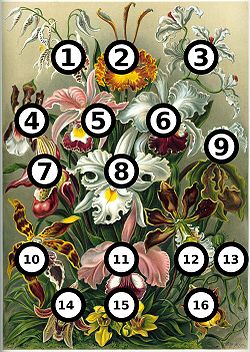
A lithographic color plate from Ernst Haeckel's Kunstformen der Natur of 1899 showing an artist's depiction of different varieties of orchids:
- Odontoglossum naevium = Odontoglossum naevium Lindl.
- Oncidium kramerianum = Psychopsis krameriana (Rchb.f.) H.G.Jones
- Odontoglossum ramosissimum = Cyrtochilum ramosissimum (Lindl.) Dalström
- Odontoglossum schroederianum = Oncidium schroederianum (O'Brien) Garay & Stacy
- Cattleya ballantiniana = Cattleya × ballantiniana Rchb.f. (C. trianae Linden & Rchb.f. × C. warscewiczii Rchb.f.)
- Cattleya mendellii = Cattleya mendelii Dombrain
- Cypripedium lemoinieri = Phragmipedium × sedenii (Rchb.f.) Rolfe (P. longifolium (Warsz. & Rchb.f.) Rolfe × P. schlimii (Linden ex Rchb.f.) Rolfe)
- Cattleya rochellensis = Cattleya warscewiczii Rchb.f.
- Cypripedium leeanum = Paphiopedilum insigne (Wall. ex Lindl.) Pfitzer × P. spicerianum (Rchb.f.) Pfitzer
- Odontoglossum wattianum = Oncidium × wattianum (Rolfe) J.M.H.Shaw, Orchid Rev. 121 (1304, Suppl.): 77. (2013)
- Cattleya labiata = Cattleya labiata
- Epidendrum atropurpureum = Encyclia cordigera (Kunth) Dressler (1964)
- Cypripedium argus = Paphiopedilum argus (Rchb.f.) Stein
- Paphinia rugosa = Paphinia rugosa Rchb.f.
- Zygopetalum xanthinum = Promenaea xanthina (Lindl.) Lindl.
- Oncidium laxense = Oncidium loxense Lindl. / Cyrtochilum loxense (Lindl.) Kraenzl.
- (center): Pegantha pantheon (Haeckel) = Pegantha pantheon Haeckel, 1879, side view
- (bottom center): Pegantha pantheon (Haeckel) = Pegantha pantheon Haeckel, 1879, single bell lobe
- (top left): Aeginura myosura (Haeckel) =? Aeginura grimaldii Maas, 1904, bottom view
- (top right): Solmaris Godeffroyi (Haeckel) = Pegantha godeffroyi (Haeckel, 1879), bottom view
- (center left): Cunarcha aeginoides (Haeckel) = Aegina citrea Eschscholtz, 1829, side view
- (bottom left): Cunarcha aeginoides (Haeckel) = Aegina citrea Eschscholtz, 1829, top view
- (top center): Cunarcha aeginoides (Haeckel) = Aegina citrea Eschscholtz, 1829, auditory tentacle
- (center right): Cunantha primigenia (Haeckel) =? Aegina sp., young medusa, side view
- (bottom right): Cunoctantha discoidalis (Haeckel) =? Cunina octonaria McCrady, 1857, top view

- Dermatochelys coriacea (Blainville) = Dermochelys coriacea (Vandelli, 1761)
- Caretta imbricata (Gray) = Eretmochelys imbricata (Linnaeus, 1766)
- Hydromeda tectifera (Wagler) = Hydromedusa tectifera Cope, 1869
- Chelys fimbriata (Duméril) = Geochelone nigra (Quoy & Gaimard, 1824)
- Testudo geometrica (Linné) = Psammobates geometricus (Linnaeus, 1758)
- Testudo elephantina (Duméril) = Dipsochelys dussumieri Gray, 1831
- Chelydra serpentina (Schweigger) = Chelydra serpentina (Linnaeus, 1758)
English:
1: Leatherback Turtle
2: Hawksbill Turtle
3: Argentine Snake-necked Turtle
4: Mata mata
5: Geometric Tortoise
6: Galápagos Tortoise

- Tetracerus quadricornis (Blainville) = Tetracerus quadricornis (Blainville, 1816)
- Catoblepas gnu (Sundevall) = Connochaetes gnou (Zimmermann, 1780)
- Tragelaphus gratus (Sclater) = Tragelaphus spekii gratus P.L.Sclater, 1880
- Antilocapra americana (Owen) / Antilope furcifera (Smith) = Antilocapra americana Ord, 1815
- Antilope ellipsiprymna (Gray) / Cervicapra ellipsiprymna (Sundevall) = Kobus ellipsiprymnus (Ogilby, 1833)
- Hippotragus niger (Harris) = Hippotragus niger Harris, 1838
- Addax nasomaculatus (Gray) = Addax nasomaculatus (Blainville, 1816)
- Tragelaphus kudu (Gray) / Antilope strepsiceros (Pallas) = Tragelaphus strepsiceros (Pallas, 1766)
- Tragelaphus scriptus (Sundevall) / Antilope maculata (Pallas) = Tragelaphus scriptus (Pallas, 1766)
Português:
1: Antílope-de-quatro-cornos, tetrácero, ou chousingha (Tetracerus quadricornis)
2: Gnu-de-cauda-branca, ou Boi-cavalo-de-cauda-branca (Connochaetes gnou)
3: Sitatunga (Tragelaphus spekei)
4: Antilocapra (Antilocapra americana) {antílope???}
5: (Kobus ellipsiprymnus), conhecido popularmente por Inhacoso ou Piva em Moçambique e por Quissema em Angola
6: Palanca-negra (nome mais usado em Angola) ou Palapala (em Moçambique), (Hippotragus niger)
7: Adax (Addax nasomaculatus)
8: Cudo (Tragelaphus strepsiceros)
9: Tragelaphus scriptus, conhecida por gazela-pintada ou imbabala, chamada ainda golungo em Angola
English:
1: Four-horned Antelope
2: Black Wildebeest
3: Sitatunga
4: Pronghorn
5: Waterbuck
6: Sable Antelope
7: Addax
8: Greater Kudu
9: Bushbuck
Deutsch:
1: Vierhornantilope
2: Wildebeest / Gnu (Haeckel), Weißschwanzgnu (Modern)
3: Sumpfantilope (Haeckel), Wald-Sitatunga (Modern)
4: Gabelantilope (Haeckel), Gabelbock (Modern)
5: Wasserbock
6: Schwarzbock (Haeckel), Rappenantilope (Haeckel/Modern)
7: Mendesantilope
8: Kudu-Antilope (Haeckel), Großer Kudu (Modern)
9: Schirrantilope (Haeckel), Buschbock (Modern)
Native names:
1: Bherki (India)
2: Imbutuma (Africa)
3: Situtunga (Africa)
4: Mazama (North America)
5: Singsing (Africa)

- Chiroteuthis Veranyi (Férussac) = Chiroteuthis veranyi (Férussac, 1835), from below
- Histioteuthis Rüppellii (Verany) = Histioteuthis bonnellii (Ferussac, 1835), from above
- Pinnoctopus cordiformis (Gaimard) = Pinnoctopus cordiformis Quoy & Gaimard, 1832, from above
- Octopus vulgaris (Lamarck) = Octopus vulgaris Cuvier, 1797, from above
- Octopus granulatus (Lamarck) = Octopus vulgaris Cuvier, 1797, from below

- Cynthia melocactus (Haeckel) = Boltenia echinata (Linnaeus, 1767), individual from above
- Cynthia melocactus (Haeckel) = Boltenia echinata (Linnaeus, 1767), individual from the front
- Cynthia melocactus (Haeckel) = Boltenia echinata (Linnaeus, 1767), individual in lengthwise section
- Molgula tubulosa (Forbes) = Eugyra arenosa (Alder & Hancock, 1848), mouth region
- Fragarium elegans (Giard) = Aplidium elegans (Giard, 1872), colony
- Polyclinum constellatum (Savigny) = Polyclinum constellatum Savigny, 1816, colony
- Polyclinum constellatum (Savigny) = Polyclinum constellatum Savigny, 1816, part of colony
- Synoecum turgens (Phipps) = Synoicum turgens Phipps, 1774, part of colony
- Botryllus polycyclus (Savigny) = Botryllus schlosseri (Pallas, 1766), part of colony
- Botryllus rubigo (Giard) = Botryllus schlosseri (Pallas, 1766), part of colony
- Botryllus Marionis (Giard) = Botryllus schlosseri (Pallas, 1766), part of colony
- Botryllus helleborus (Giard) = Botryllus schlosseri (Pallas, 1766), part of colony
- Polycyclus cyaneus (Drasche) = Botryllus schlosseri (Pallas, 1766), colony
- Botrylloides purpureus (Drasche) = Botrylloides leachii (Savigny, 1816), part of colony
See here for index to numbers.
- Sabella spectabilis (Grube) = Sabellastarte indica (Savigny, 1822)
- Serpula contortuplicata (Linné) = Hydroides norvegicus Gunnerus, 1768
- Spirographis spallanzanii (Viviani) = Sabella spallanzanii (Gmelin, 1791)
- Terebella emmalina (Quatrefages) = Pista cretacea (Grube, 1860)
- Eunice magnifica (Quatrefages) = Eunice magnifica Grube, 1866
- Hermione hystricella (Quatrefages) = Hermione hystricella Milne-Edwards in Cuvier, 1836
- Cloëia euglochis (Ehlers) = Chloeia viridis Schmarda, 1861

- Alucita hexadactyla (Linné) / Orneodes hexadactyla Spuler = Alucita hexadactyla Linnarus, 1758
- Pterophorus pentadactylus (Linné) / Aciptilia pentadactyla (Hübner) = Pterophorus pentadactyla (Linnaeus, 1758) (2a, 2b: wing scales)
- Pterophorus rhododactylus (Linné) / Cnaemidophorus rhododactylus (Wallengren) = Cnaemidophorus rhododactyla (Denis & Schiffermüller, 1775)
- Lithocolletis populifolia (Treitschke) / Gracilaria populifolia (Zeller) = Phyllonorycter populifoliella (Treitschke, 1833)
- Plutella xylostella (Zeller) / Cerostoma xylostella (Latreille) = Plutella xylostella Linnaeus, 1777 (5a, 5b: wing scales)
- Harpella geoffroyella (Schanck) / Geoffroyella gruneriella (Schäffer) = Alabonia geoffrella (Linnaeus, 1767)
English:
1: Twenty-plume moth
2: White Plume Moth
See here for index to numbers
- Astrosphaera stellata (Haeckel) = Astrosphaera sp.?
- Hexancistra quadricuspis (Haeckel) = Hexancistra quadricuspis (Haeckel, 1887)
- Cannartidium mammiferum (Haeckel) = Didymocyrtis mammifera (Haeckel, 1887)
- Cannartidium mastophorum (Haeckel) = Artiscinae sp.?
- Cannartiscus amphiconiscus (Haeckel) = Cannartus violina Haeckel, 1887?
- Cyphinus amphilophus (Haeckel) = Cyphinus amphilophus Haeckel, 1887
- Panartus diploconus (Haeckel) = Panartus diploconus Haeckel, 1887
- Peripanartus amphiconus (Haeckel) = Peripanartus amphiconus Haeckel, 1887
- Panicium coronatum (Haeckel) = Panicium coronatum Haeckel, 1887
- Peripanicium amphicorona (Haeckel) = Peripanicium amphicorona Haeckel, 1887
- Trochodiscus stellaris (Haeckel) = Trochodiscus stellaris Haeckel, 1887
- Dicranastrum bifurcatum (Haeckel) = Tetracranastrum bifurcatum (Haeckel, 1887)
- Archidiscus pyloniscus (Haeckel) = Archidiscus sp.?
- Pylodiscus triangularis (Haeckel) = Hexapyle cf. dodecantha Haeckel, 1887
- Tholoma metallasson (Haeckel) = Cubotholus octoceras Haeckel, 1887?
Enlarge image for index to numbers.
- Cristatella mucedo (Cuvier) = Cristatella mucedo Cuvier 1798, immature statoblast
- Cristatella mucedo (Cuvier) = Cristatella mucedo Cuvier 1798, mature statoblast
- Cristatella mucedo (Cuvier) = Cristatella mucedo Cuvier 1798, young colony
- Cristatella mucedo (Cuvier) = Cristatella mucedo Cuvier 1798, mature colony
- Cristatella mucedo (Cuvier) = Cristatella mucedo Cuvier 1798, mature colony in cross-section
- Plumatella repens (Lamarck) = Plumatella repens (Linnaeus 1758), individual before colony formation
- Plumatella repens (Lamarck) = Plumatella repens (Linnaeus 1758), young colony
- Plumatella repens (Lamarck) = Plumatella repens (Linnaeus 1758), part of young colony
- Alcyonella flabellum (Van Beneden) = Plumatella fungosa (Pallas 1768), young colony
- Lophopus crystallinus (Dumortier) = Cristatella mucedo Cuvier 1798, young colony
- Lophopus crystallinus (Dumortier) = Cristatella mucedo Cuvier 1798, young developing individual in colony
- Lophopus crystallinus (Dumortier) = Cristatella mucedo Cuvier 1798, older developing individual in colony

- Hermaea bifida (Lovén) = Hermaea bifida (Montagu, 1815)
- Aeolis coronata (Forbes) = Facelina auriculata coronata (Forbes & Goodsir, 1839)
- Dendronotus arborescens (Alder) = Dendronotus frondosus (Ascanius, 1774)
- Idalia elegans (Leuckart) = Okenia elegans (Leuckart, 1828)
- Doto coronata (Lovén) = Doto coronata (Gmelin, 1791)
- Tritonia Hombergii (Cuvier) = Tritonia hombergii Cuvier, 1803
- Ancula cristata (Lovén) = Ancula gibbosa (Risso, 1818)
- (center): Alsophila sp. (in Cyatheaceae)
- (left): Polypodium sp. (in Polypodiaceae)
- (right): Asplenium nidus = Asplenium nidus L.
- (bottom left, above): Angiopteris sp. (in Marattiaceae)
- (bottom left, below): Monogramma sp. (in Pteridaceae)
- (bottom right): Pteris quadriaurita = Pteris quadriaurita Retz.

- Calcar triumphans (Philippi) = Guildfordia triumphans (Philippi, 1841), from above
- Conus imperialis (Linné) = Conus imperialis Linnaeus, 1758[1]
- Harpa ventricosa (Lamarck) = Harpa Röding Röding, 1798[2]
- Murex tenuispinus (Lamarck) = Murex pecten pecten Lightfoot, 1786[3]
- Murex inflatus (Lamarck) = Chicoreus ramosus (Linnaeus, 1758)[4]
- Fusus longicauda (Lamarck) = Fusinus colus (Linnaeus, 1758)[5], cut open
- Astralium imperiale (Chemnitz) = Astraea heliotropium Martyn, 1784, from below
- Astralium imperiale (Chemnitz) = Astraea heliotropium Martyn, 1784, from above Astraea heliotropium
- (top center): Porpema medusa (Haeckel) = Porpema prunella (Haeckel, 1888), adult colony, side view
- (top left, upper): Porpema medusa (Haeckel) = Porpema prunella (Haeckel, 1888), adult colony, group of sexual polyps
- (top right, upper): Porpema medusa (Haeckel) = Porpema prunella (Haeckel, 1888), adult colony, gas bladder
- (center right): Porpema medusa (Haeckel) = Porpema prunella (Haeckel, 1888), adult colony, side view without tentacles
- (bottom right): Porpalia prunella (Haeckel) = Porpema prunella (Haeckel, 1888), adult, top view
- (top left, lower): Discalia medusina (Haeckel) = Porpema prunella (Haeckel, 1888)?, young colony, bottom view without tentacles
- (center left): Discalia medusina (Haeckel) = Porpema prunella (Haeckel, 1888)?, young colony, side view
- (center): Disconalia gastroblasta (Haeckel) = Porpita sp., young colony, bottom view
- (top right, lower): Disconalia gastroblasta (Haeckel) = Porpita sp., very young colony, bottom view without tentacles
- (bottom left, left half): Disconalia gastroblasta (Haeckel) = Porpita sp., young colony, horizontal section through upper bell
- (bottom left, right half): Disconalia gastroblasta (Haeckel) = Porpita sp., young colony, horizontal section through lower bell
- (bottom center): Disconalia gastroblasta (Haeckel) = Porpita sp., young colony, sexual polyp
Hummingbirds (drawn from millinery specimens, body positions are not natural)
Enlarge image for index to numbers.
- Gemmaria sagittaria (Haeckel) = Zanclea gemmosa Mac Grady, 1857, young medusa from the side
- Rathkea fasciculata (Haeckel) = Koellikerina fasciculata (Péron & Lesueur, 1810), medusa from above
- Tiara pileata (Haeckel) = Neoturris pileata (Forskål, 1775), medusa from below
- Tiara pileata (Haeckel) = Neoturris pileata (Forskål, 1775), internal organs from the side
- Stomotoca pterophylla (Haeckel) = Larsonia pterophylla (Haeckel, 1879), internal organs from the side
- Thamnostylus dinema (Haeckel) = Sarsiella dinema Haeckel, 1879? (=Leuckartiara), medusa from the side

- Plecotus auritus (Geoffroy) = Plecotus auritus (Linnaeus, 1758)
- Plecotus auritus (Geoffroy) = Plecotus auritus (Linnaeus, 1758), head from front
- Nyctophilus australis (Peters) = Nyctophilus geoffroyi geoffroyi Leach, 1821, head from front
- Megaderma trifolium (Geoffroy) = Megaderma spasma trifolium Geoffroy, 1810, head from front
- Vampyrus auritus (Peters) = Chrotopterus auritus (Peters, 1856), head from the side
- Lonchorhina aurita (Tomes) = Lonchorhina aurita Tomes, 1863, head from front
- Lonchorhina aurita (Tomes) = Lonchorhina aurita Tomes, 1863, head from backside
- Natalus stramineus (Gray) = Natalus stramineus Gray, 1838, head from front
- Mormoops blainvillei (Peters) = Mormoops blainvillii Leach, 1821, head from front
- Anthops ornatus (Thomas) = Anthops ornatus Thomas, 1888, face from front
- Phyllostomus hastatum (Pallas) = Phyllostomus hastatus (Pallas, 1767), head from front
- Furipterus coerulescens (Tomes) = Furipterus horrens (F.Cuvier, 1828), head from front
- Rhinolophus equinus (Schreber) = Rhinolophus ferrumequinum (Schreber, 1774), head from front
- Centurio flavigularis (Peters) = Centurio senex Gray, 1842, head from front
- Vampyrus spectrum (Geoffroy) = Vampyrum spectrum (Linnaeus, 1758), head from front
English:
1-2: Brown Long-eared Bat
3: Lesser Long-eared Bat
4: Lesser False Vampire Bat
5: Big-eared Woolly Bat
6-7: Tomes's Sword-nosed Bat
8: Mexican Funnel-eared Bat
9: Antillean Ghost-faced Bat
10: Flower-faced Bat
11: Greater Spear-nosed Bat
12: Thumbless Bat
13: Greater Horseshoe Bat
14: Wrinkle-faced Bat
15: Spectral Bat
Full text description (in German):

- Notodelphys ovifera (Weinland) = Gastrotheca ovifera (Lichtenstein & Weinland, 1854)
- Hyla meridionalis (Boulenger) = Hyla meridionalis Boettger, 1874
- Hyla tuberculosa (Boulenger) = Ecnomiohyla tuberculosa (Boulenger, 1882)
- Amphignathodon Güntheri (Boulenger) = Gastrotheca guentheri (Boulenger, 1882)
- Rhacophorus pardalis (Wallace) = Rhacophorus pardalis Günther, 1858
- Hylodes lineatus (Schneider) = Lithodytes lineatus / Leptodactylus lineatus (Schneider, 1799)
- Limnodytes erythraeus (Duméril) = Hylarana erythraea (Schlegel, 1837)
- Ceratobatrachus Güntheri (Boulenger) = Ceratobatrachus guentheri Boulenger, 1884
- Breviceps mossambicus (Peters) = Breviceps mossambicus Peters, 1854
- Lithobates pipiens (Linné) = Rana pipiens (Schreber, 1782)
Full text description (in German):
English translation: [Remarks made by the translator are in italics or square brackets]
Fig. 1. The pouch frog of Venezuela is remarkable for its female's possession of a paired dorsal [back] pouch, in which the eggs remain until the hatching of the tadpoles. A narrow triangular gap at the rear of the back (in the centre of the lightly coloured saddle patch) leads to the pouch.
Fig. 2.Mediterranean Tree Frog, Stripeless Tree Frog
The treefrog of North Africa and Southern Europe is little different from our native common green treefrog (Hyla arborea) and like the latter lives on trees and shrubs. When crying [calling], the male pushes forward the vocal sac like a bubble.
Fig. 3. The treefrog of Ecuador is characterised by the crude build of its thick fingers (with very wide contact plates) and the knobbly skin, that like in toads is covered in glandular warts.
Fig. 4. The climbing frog of Ecuador is among the slimmest and most supple forms of treefrogs; his extraordinarily thin and long limbs (with zebralike dark stripes across) enable it of the most dexterous climbing arts.
Fig. 5. The flying frog of Borneo is remarkable above all other Batrachids for its extraordinarily widened foot webbings between the elongated toes. If the flying frog spreads these webs while jumping from tree to tree, he can use them as a parachute, similar to the flying dragon (Draconellus) among the reptiles (Plate 79) and the flying squirrels (Pteromys) among the rodents.
Fig. 6. The military frog of Surinam is very peculiar in that the female carries its young on its back in military rank. The little tadpoles, numbering 12 to 20, attach to two diverging back ridges of the mother (that run symmetrically either side of the dorsal central line) by their oral suction plates. The mobile rudder tails are turned outward, on the left side as on the right.
Fig. 7. The banded frog of Java has two parallel white bands on its back, running lengthwise, that contrast strongly against the dark red brown base colour. The jumping treefrog is about to capture an insect with its protruded bicornuated tongue.
Fig. 8. The tip frog from the Solomon Islands is assigned to the group of "horn frogs" that are distinguished by a pair of sharp horns on top of the triangular head; these are elongated coverings of the upper eye lids. The bright colouration and patterning of this horn frog is most variable and often adapted to its environment.
Fig. 9. The thickhead frog from East Africa (Mozambique, Sambesi) deviates from all other frogs in the appearance of its very short and thick head. Furthermore, it cannot jump with its short and weak legs, and moves its fat, crude body only with difficulty. The hind feet have large, spade-like digging swellings that help it to rapidly dig itself into the soil. It feeds on termites and in its subterranean habits is equal to the moles.
Fig. 10. Northern Leopard Frog
Enlarge image for index to numbers.
- Codonella campanella (Haeckel) = Tintinnopsis campanula (Ehrenberg, 1840), shell with individual inside (genus Tintinnopsis)
- Dictyocysta tiara (Haeckel) = Dictyocysta elegans Ehrenberg, 1854, shell (genus Dictyocysta)
- Dictyocysta templum (Haeckel) = Dictyocysta elegans Ehrenberg, 1854, shell
- Tintinnopsis campanula (Claparède) = Tintinnopsis campanula (Ehrenberg, 1840), shell
- Cyttarocylis cistellula (Fol) = Codonaria cistellula (Fol, 1884), shell (genus Codonaria)
- Petalotricha galea (Haeckel) (non Haeckel, 1873: preoccupied) = Codonella aspera Kofoid & Campbell, 1929, shell (genus Codonella)
- Stentor polymorphus (Ehrenberg) = Stentor polymorphus (O.F.Müller, 1773), individual (genus Stentor)
- Stentor polymorphus (Ehrenberg) = Stentor polymorphus (O.F.Müller, 1773), group
- Freia ampulla (Claparède) (non O.F.Müller, 1786: preoccupied) = Ascobius claparedi Hadzi, 1951, individual (genus Ascobius)
- Vorticella convallaria (Ehrenberg) = Vorticella convallaria Linnaeus, 1758, group (genus Vorticella)
- Carchesium polypinum (Ehrenberg) = Carchesium polypinum Linnaeus, 1758, colony, relaxed (genus Carchesium)
- Carchesium polypinum (Ehrenberg) = Carchesium polypinum Linnaeus, 1758, colony, contracted
- Epistylis flavicans (Ehrenberg) = Campanella umbellaria Linnaeus, 1767, colony (genus Campanella)
- Zoothamnium arbuscula (Ehrenberg) = Zoothamnium arbuscula Ehrenberg, 1839, young colony
- Zoothamnium arbuscula (Ehrenberg) = Zoothamnium arbuscula Ehrenberg, 1839, old colony

- Heliactis bellis (Thompson) = Cereus pedunculatus (Pennant, 1777)
- Mesacmaea stella [sic] (Andres) = Mesacmaea stellata (Andrès, 1881)
- Aiptasia Couchii (Gosse) = Aiptasia mutabilis (Gravenhorst, 1831)
- Cylista impatiens (Dana) = Choriactis impatiens (Couthouy in Dana, 1846)
- Bunodes thallia (Gosse) = Anthopleura thallia (Gosse, 1854)
- Metridium praetextum (Couthouy) = Actinostella flosculifera (Lesueur, 1817)
- Heliactis troglodytes (Thompson) = Sagartia troglodytes (Price, 1847)
- Anthea cereus (Gosse) = Anemonia sulcata (Pennant, 1777)
- Aiptasia undata (Martens) = Aiptasia diaphana (Rapp, 1829)
- Aiptasia diaphana (Andres) = Aiptasia diaphana (Rapp, 1829)
- Bunodes monilifera (Dana) = Paractis monilifera (Drayton in Dana, 1846)
- Corynactis viridis (Allman) = Corynactis viridis Allman, 1846
- Metridium concinnatum (Dana) = Oulactis concinnata (Drayton in Dana, 1846)
- Sagartia chrysoplenium (Gosse) = Chrysoela chrysosplenium (Cocks in Johnston, 1847)
- Actinoloba dianthus (Blainville) = Metridium senile (Linnaeus, 1761)
- (top center): Codonium codonophorum (Haeckel) = Coryne prolifera (Forbes, 1848), medusa budding off medusae = Codonium proliferum
- (top, right of center): Dipurena dolichogaster (Haeckel) = Dipurena ophiogaster (Haeckel, 1877), medusa = Stauridiosarsia ophiogaster
- (top, left of center): Sarsia tubulosa (Lesson) = Sarsia tubulosa (M.Sars, 1835), medusa
- (top right, above): Sarsia tubulosa (Lesson) = Sarsia tubulosa (M.Sars, 1835), medusa, view inside bell from below
- (top left, above): Thamnocnidia coronata (L.Agassiz) = Ectopleura larynx (Ellis & Solander, 1786), polyp, mouth from above
- (top right, below): Thamnocnidia coronata (L.Agassiz) = Ectopleura larynx (Ellis & Solander, 1786), young larva
- (top left, below): Thamnocnidia coronata (L.Agassiz) = Ectopleura larynx (Ellis & Solander, 1786), actinula (older larva)
- (left): Monocaulus pendulus (Allman) = Corymorpha pendula L.Agassiz, 1862, polyp
- (right): Corymorpha nutans (Sars) = Corymorpha nutans Sars, 1835, polyp budding off medusae
- (bottom center): Tubuletta splendida (Haeckel) = Corymorpha sp.?, polyp
- (bottom left): Syncoryne pulchella (Allman) = Coryne pulchella (Allman, 1865), polyp budding off medusae = Sarsia pulchella
- (bottom right): Myriothela phrygia (Fabricius) = Candelabrum phrygium (Fabricius, 1780), polyp
For index to numbers, see here.
- Thamnium alopecurum (Linné) = Thamnobryum alopecurum (Hedw.) Nieuwl. ex Gangulee
- Eurhynchium praelongum (Linné) = Eurhynchium pumilum (Wilson) Schimp.
- Polytrichum commune (Linné) = Polytrichum commune Hedw.
- Sphagnum cymbifolium (Ehrhard) = Sphagnum palustre L.
- Splachnum luteum (Linné) = Splachnum luteum Hedw.
- Mnium undulatum (Hedwig) = Hypnum ligulatum F.Weber & D.Mohr
- Rhodobryum roseum (Schreber) = Rhodobryum roseum (Hedw.) Limpr.
- Physcomitrium acuminatum (Schleich.) = Physcomitrium eurystomum Sendtn.
- Physcomitrium ericetorum (Notaris) = Physcomitrium ericetorum (De Not.) Bruch & Schimp.
- Physcomitrium sphaericum (Schwaeg.) = Physcomitrium sphaericum (C.F. Ludw.) Fürnr.
- Sphagnum medium (Limpricht) = Sphagnum magellanicum Brid.
- Andreaea Thedenii (Schimper) = Andreaea obovata Thed.
- Hypnum castrense (Linné) = Hypnum crista-castrensis Hedw.
- Tetraplodon urceolatus (Schimper) = Tetraplodon urceolatus (Hedw.) Bruch & Schimp.
- Dissodon Hornschuchii (Greville) = Tayloria hornschuchii (Grev. & Arn.) Broth.
- Dissodon Froelichii (Hedwig) = Tayloria froelichiana (Hedw.) Mitt. ex Broth.
- (top center): Lithocircus magnificus (Haeckel) = Lithocircus sp.?, living animal
- (top left): Semantis sigillum (Haeckel) = Tholospyris procera Goll, 1969?, skeleton of juvenile
- (bottom left, upper): Acanthodesmia corona (Haeckel) = Acanthodesmia sp?, skeleton
- (center right, upper): Tristephanium dimensivum (Haeckel) = Tristephanium dimensivum Haeckel, 1887?, skeleton
- (center): Trissocyclus sphaeridium (Haeckel) = Trissocyclidae sp.?, living animal
- (center right, lower): Octotympanum cervicorne (Haeckel) = Acanthodesmia viniculata (Müller, 1857)?, skeleton
- (bottom right, upper): Microcubus zonarius (Haeckel) = Amphispyris zonarius (Haeckel, 1887)?, skeleton
- (top right): Tympaniscus tripodiscus (Haeckel) = Trissocyclidae sp.?, skeleton
- (center left, upper): Tympaniscus quadrupes (Haeckel) = Trissocyclidae?, skeleton
- (bottom center): Tympanidium foliosum (Haeckel) = Tympanidium foliosum Haeckel, 1887, living animal
- (bottom left, lower): Lithotympanum tuberosum (Haeckel) = Lithotympanum tuberosum Haeckel, 1887, living animal
- (center left, lower): Circotympanum octogonium (Haeckel) = Nassellaria sp.?, skeleton
- (bottom right, lower): Lithocubus astragalus (Haeckel) = Lithocubus ap., living animal

- Araucaria brasiliana (Lamb) = Araucaria angustifolia (Bertol.) Kuntze, female cone
- Picea excelsa (Link) = Picea abies (L.) H.Karst., scale of female cone from inside
- Abies bracteata (Hooker) = Abies bracteata (D.Don) Poit., female cone
- Chamaecyparis obtusa (Siebold) = Chamaecyparis obtusa (Siebold & Zucc.) Endl., branch with female cones
- Thujopsis dolabrata (Siebold) = Thujopsis dolabrata (Linnaeus, 1758)(Thunb. ex L.f.) Siebold & Zucc., branch with 12 male and 3 female cones
- Juniperus communis (Linné) = Juniperus communis L., branch with fruit
- Libocedrus decurrens (Torr) = Calocedrus decurrens (Torr.) Florin, branch with female cones
- Phyllocladus rhomboidalis (Richard) = Phyllocladus aspleniifolius (Labill.) Hook.f., branch with female cones
- Ginkgo biloba (Linné) = Ginkgo biloba L., branch with seed
- Sequoya gigantea (Torr) = Sequoiadendron giganteum (Lindl.) J.Buchholz, female cone
- Cupressus sempervirens (Linné) = Cupressus sempervirens L., branch with 7 male and 2 female cones
- Taxodium distichum (Richard) = Taxodium distichum (L.) Rich., female cone
- Pinus serotina (Linné) = Pinus serotina Michx., female cone

- Parthenope horrida (Fabricius) = Daldorfia horrida (Linnaeus, 1758)
- Podophthalmus vigil (Leach) = Podophthalmus vigil (Fabricius, 1798)
- Pisa armata (Leach) = Pisa armata (Latreille, 1803)
- Gonoplax rhomboides (Desmarest) = Goneplax rhomboides (Linnaeus, 1758)
- Pisolambrus nitidus (Milne Edwards) = Solenolambrus tenellus Stimpson, 1871
- Stenopus hispidus (Latreille) = Stenopus hispidus (Olivier, 1811)
- Palaemon serratus (Fabricius) = Palaemon serratus (Pennant, 1777)
- Albunea symnista (Fabricius) = Albunea symmysta (Linnaeus, 1758)
- Lissa chiragra (Leach) = Lissa chiragra (Fabricius, 1775)
- Birgus latro (Herbst) = Birgus latro (Linnaeus, 1767)

- Chamaeleon montium (Buchholz) = Trioceros montium/Chamaeleo montium Buchholz, 1874 (See Trioceros montium)
- Lophyrus tigrinus (Duméril) = Gonocephalus chamaeleontinus Laurenti, 1768 (See Gonocephalus chamaeleontinus)
- Draconellus volans (Linné) = Draco volans Linnaeus, 1758 (See Draco volans)
- Phrynosoma cornutum (Wiegmann) = Phrynosoma cornutum (Harlan, 1825) (See Phrynosoma cornutum)
- Ptychozoon homalocephalum (Kuhl) = Ptychozoon kuhli Stejneger, 1902 (See Ptychozoon kuhli)
- Basiliscus americanus (Daudin) = Basiliscus basiliscus (Linnaeus, 1758) (See Basiliscus basiliscus)
- Chlamydosaurus kingii (Gray) = Chlamydosaurus kingii Gray, 1827 (See Chlamydosaurus kingii)
- Moloch horridus (Gray) = Moloch horridus Gray, 1841 (See Moloch horridus)
English:
- Cameroon Sailfin Chameleon
- Chameleon Forest Dragon
- Flying Dragon
- Texas Horned Lizard
- Kuhl's Flying Gecko
- Common Basilisk
- Frill-necked Lizard
- Thorny Devil
The 79th lithographic plate from Ernst Haeckel's Kunstformen der Natur (1904) depicts a variety of lizards, or Lacertilia. In terms of evolutionary relationships, these eight lizards demonstrate the diversity of the suborder Lacertilia, which has been replaced by an array of new suborders and infraorders in recent classifications. Unusual species of chameleon and gonocephalus are at the top; the second row has a flying dragon and a Texas horned lizard; the third row has a flying gecko and a common basilisk; on the bottom row are the aptly named frill-necked lizard and the Thorny Devil. As in many of Haeckel's prints, the colors and spatial composition are more of an aesthetic choice than a reproduction of nature; the lithographer Adolf Glitsch worked directly from Haeckel's sketches rather than from first-hand specimens.
(Olaf Breidbach (2004): Visions of Nature: The Art and Science of Ernst Haeckel. Prestel, New York, USA.)
Full text description (in German):

- Calanus pavo (Dana) = Calocalanus pavo (Dana, 1852), male
- Clytemnestra scutellata (Dana) = Clytemnestra scutellata Dana, 1849, female
- Oncaea venusta (Philippi) = Oncaea venusta Philippi, 1843, male
- Cryptopontius thorelli (Giesbrecht) = Cryptopontius thorelli Giesbrecht, 1899, female
- Acontiophorus scutatus (Brady) = Acontiophorus scutatus (Brady & Robertson D., 1873), female
- Corycaeus venustus (Dana) = Corycaeus venustus Dana, 1849, female
- Sapphirina Darwinii (Haeckel) = Sapphirina darwini Haeckel, 1864, female
- Augaptilus filigerus (Giesbrecht) = Euaugaptilus filigerus (Claus, 1863), male
Full text description (in German):



